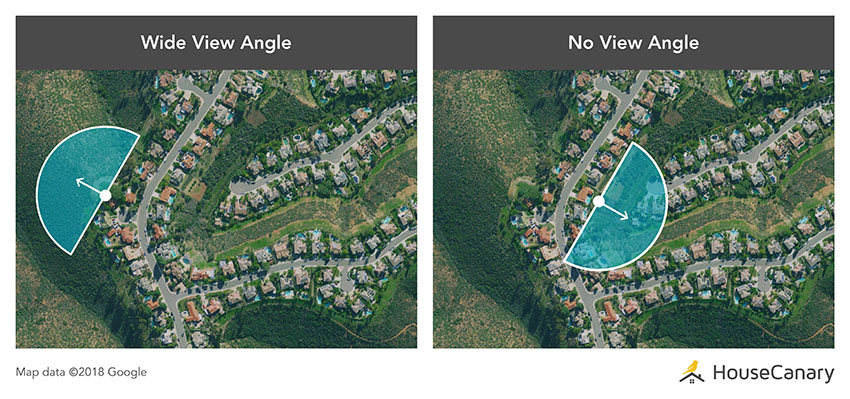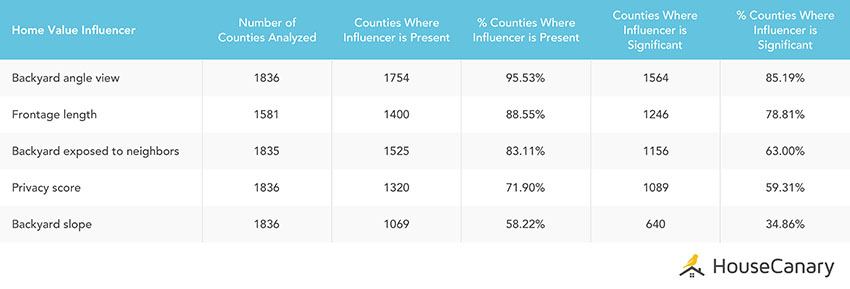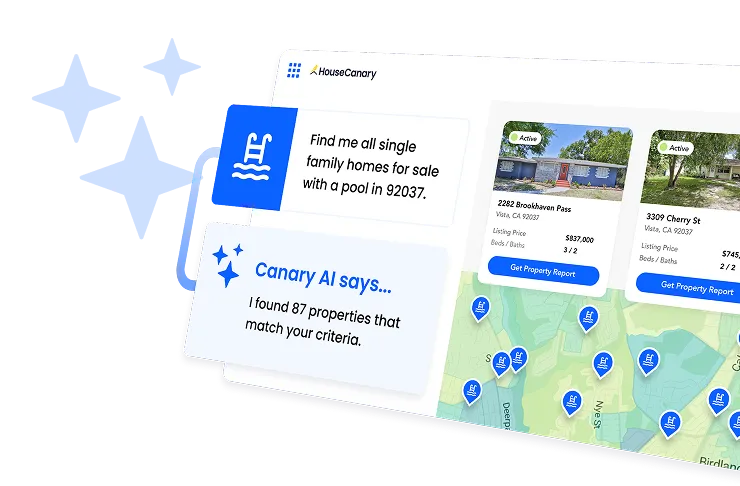
When you’re shopping for (or selling) a home, it’s normal to wonder why one home is priced five or six figures higher or lower than another home on the same block. Some factors that influence a home’s value are obvious, but what about some of those price-influencers that are a little less obvious and more difficult to measure? HouseCanary examined five “hidden” factors that can have an impact on home value:
- View angle from backyard
- Frontage length
- Backyard exposure to neighbors
- Privacy score
- Backyard slope
We controlled for other value influencers, such as location, lot size, gross living area (square footage), and more, so we could isolate the effect of these hidden factors. And we found that the relative importance of these factors can vary widely according to where the home is located.
Interactive image key: Blue shows positive correlation and yellow shows negative correlation. Impact is shown on a 0-100 scale, with 0 indicating no impact and 100 indicating significant impact.
See this image in a new window.
View angle from backyard
The view angle calculates the maximum angle (in degrees) that opens up to scenery or nature from your backyard. The degrees measured are 0 to 180, showing the maximum angle of scenery viewable from your backyard, with 0 indicating that there is no scenic view at all from your backyard, and 180 indicating that the view is scenic from every angle.

This was the most popular hidden factor influencing home values in our analysis, emerging in 1,754 of 1,836 counties (95.53%). In those counties, larger view angles correlated with higher home values, showing that buyers in those areas put a premium value on their backyard views. Many counties in the Midwest in particular tend to prize backyard view angle; in Kansas City or Indianapolis, for example, a wide view angle will probably drive a home’s value upward — but those sweeping views don’t have as big an impact on home value in cities like Denver or Las Vegas in the West.
Frontage length
The frontage length is the length (in feet) of the street-facing side of the home’s lot. It doesn’t always correlate perfectly with lot size because not all lots are square, but it indicates the amount of curb-facing home relative to other homes in the area — and believe it or not, homes with more curb to appeal do tend to have more curb appeal in some parts of the country.
We saw that frontage length boosts a home’s value in 1,246 of 1,581 counties analyzed. It’s clear from the map that counties in the South tend to place higher relative importance on frontage length. Frontage length is going to be a bigger driver of home value in Charlotte, South Carolina, or Athens, Georgia, than it is in Salt Lake City, Utah, or in San Francisco.
Backyard exposure to neighbors
Most home buyers in the U.S. not only want a nice view from the backyard; they also don’t want someone else’s nice view to include their home or yard. The angle of backyard exposure to neighbors is a measurement of how easily neighbors can see into a home and backyard, thus potentially mitigating privacy. It’s also measured in degrees from 0 to 180, with 0 indicating no exposure at all of your backyard or home to neighbors, and 180 indicating total exposure.
Backyard exposure to neighbors was a negative influential factor in 1,156 counties out of 1,835 counties analyzed — in other words, the more backyard was exposed to neighbors, the lower the home’s value in those counties. This was especially clear in the Northeast, which seems to place more importance on limiting backyard exposure than other parts of the country — in Rochester, New York, or Boston, Massachusetts, homes with less backyard exposure were more highly valued, and in some parts of the country, like Buffalo, Wyoming, and just south of Spokane, Washington, homes with more backyard exposure to neighbors actually had higher values.
Privacy score
How private is a home, and how much will that matter when it comes time to sell? We examined backyard exposure to neighbors, backyard slope, distance to neighbors, home density, and other metrics to determine a privacy score and show how much privacy matters in different parts of the country.
We found that in 1,089 of the 1,836 counties studied, homes with higher privacy scores also have higher values. Rural areas in particular seem to place heavy value on a home’s privacy, but that doesn’t always hold true; homebuyers in Dallas want privacy, but in counties surrounding Dallas, a lower privacy score might generate a higher home value — perhaps because privacy is abundant in those areas, and homeowners are less willing to pay a premium for it.
Backyard slope
Would you prefer your backyard to slope up or slope down? This is a factor that many buyers value, although they might not be able to verbalize it. We found that in 640 of 1,836 counties checked, there is a negative relationship between home value and backyard slope. In those counties, homes with backyards that slope uphill have lower values than homes with backyards that slope downhill from the primary residence on the property — showing that homes with downhill-sloping backyards tend to be more desirable.
This doesn’t necessarily mean that homes with flat yards are neutral or undesirable, that said; flat yards are more desirable than yards that slope uphill. But it does mean that slope matters in a lot of the country, most notably counties in Minnesota and Indiana, both states that contain a mixture of mountains or rolling hills and flat terrain. And the backyard slope trend is more pronounced in Seattle than Los Angeles, which are both hilly metro areas, suggesting that perhaps Seattleites spend more time on their back decks looking at the cityscape than Angelenos do.

To learn more about how these factors influence home value in your county, contact press@housecanary.com
Methodology
HouseCanary built regression models to predict value based on view angle, frontage length, backyard exposed angle, privacy score, and backyard slope. In these models, we also controlled for common explainers of value (location, building area, lot size, etc.). We included 1,836 counties for view angle, privacy score, and backyard slope; 1,835 counties for backyard exposed angle; and 1,581 counties for frontage length.
Key takeaways
- View angle from backyard, frontage length, backyard exposure to neighbors, privacy score, and backyard slope are five “hidden” factors that influence a home’s value.
- The degree to which each factor influences a home’s value varies widely according to the region, county, or neighborhood where the home is located.























